Shamanic Journey into Truth, Wisdom & Freedom
April 18 – 22 (5 days)
Awarded:
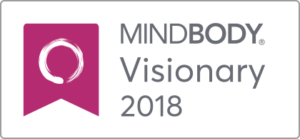
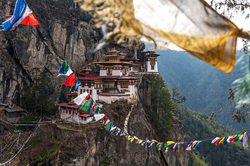 The magic of Bhutan is not describable with words. The simplicity of how the locals live and how in tune with nature they are, definitely plays a big part in its beauty. The temples are charged with years and years of focused meditation and spiritual energy, creating a very real field that can be felt. It’s the perfect place for transformational processes.
The magic of Bhutan is not describable with words. The simplicity of how the locals live and how in tune with nature they are, definitely plays a big part in its beauty. The temples are charged with years and years of focused meditation and spiritual energy, creating a very real field that can be felt. It’s the perfect place for transformational processes.
This retreat is for you if you are looking to connect to yourself more deeply. It is for those who are courageous and ready to change from the inside out. This trip is not for those with flitting curiosity, nor for those who are looking to play the role of ‘tourist’.
Why you will come on this particular journey is because there is a deep longing in your heart to experience who you authentically are. Through the practices of yoga, meditation and the Inner Guidance process, you will start to unfold more deeply into your truth while embodying more joy and love in the here and now.
THIS RETREAT IS LIMITED TO 10 PEOPLE TO MAINTAIN AN INTIMATE EXPERIENCE. TO ENSURE WE DELIVER THE BEST EXPERIENCE TO YOU, PLEASE EMAIL INFO@EXODUSRETREATS.COM WITH ANSWERS OF THE QUESTIONNAIRE BELOW:
Please answer the following questions in your email:
1) Do you have a regular yoga or meditation practice? If so for how long?
2) What is your view on spirituality and how open are you to new and unfamiliar experiences?
3) Do you have any food allergies or medical conditions that need to be taken into consideration?
4) What are the 3 main things in which you are actively seeking to transform your life at this point in time? Please be specific.
Please answer with honesty and a willingness for a committed journey deep into the heart of the Self. Emails will be followed up with a phone call or Skype meeting.
Your Guides on this Unique Adventure
 Johnson Chong
Johnson Chong
Johnson is the Founder of Sagehouse in Singapore and the Creator of Exodus Retreats, where he and other facilitators create transformational experiences visiting places around the world that support conscious shifts.
Johnson is a Sage Coach, and helps guide his clients through challenging crossroads by drawing on his rich knowledge of the mind, body and spirit from various wisdom traditions. He brings a fresh and practical lens to integrating spirituality with an urban modern lifestyle, and serves as a bridge for those who are waking up.
He is an advanced certified vinyasa yoga teacher with over 1000 hours of training and education in conscious movement including yoga, pilates apparatus and Gyrotonic. As a certified advanced Thai yoga massage therapist, and Master Reiki Healer of the Usui Reiki lineage and the Osho Reiki lineage, he has worked with hundreds of clients in pain management, and discovered that common thread in most people is an unresolved emotional story.
Johnson also is an Inner Guidance Facilitator and Meditation teacher who draws from the diverse influences of shamanic journeying, inner visualization and an array of wisdom traditions that seek to amplify our birthright of being connected to our inner wisdom and peace.
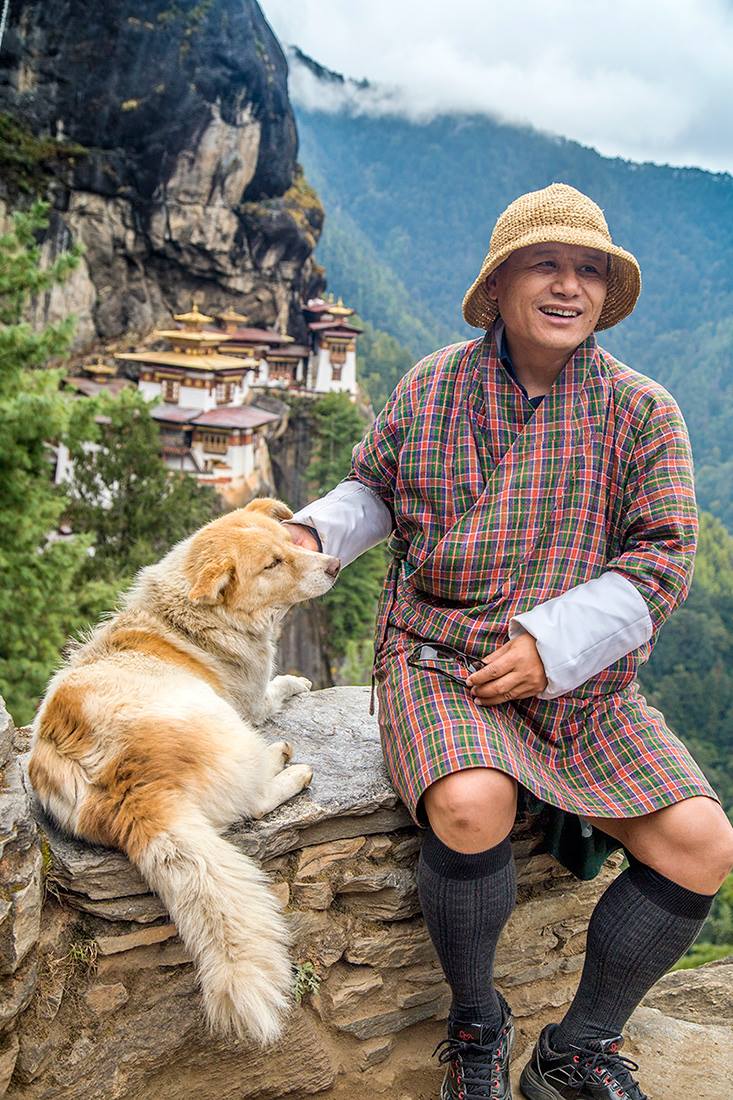 Dr. Karma Wangchuk
Dr. Karma Wangchuk
Dr. Karma Wangchuk is the creator of Vajra Guru Spiritual Travels, a registered travel agency in the Kingdom of Bhutan.
As a practitioner of the Nyingmapa and Kagyupa traditions of Mahayana & Vajrayana Buddhism for many years, Vajra Guru Spiritual Travels has been established with the aim to serve and guide especially spiritual and Dharma seekers through theoretical and practical experiences while in the Kingdom of Bhutan.
For eight years between 1986 – 1994, he lived as a Buddhist monk under Kalu Rinpoche and Drupchen Rinpoche. During his monk-hood, he acquired a Gold Medal in his M.A Buddhist Studies Program, and proceeded to earn a PhD from the University of Delhi in Buddhist Studies.
He is a sought after lecturer in Tibetan Buddhism and Spirituality, and has held various positions in the government and privately. Currently, Dr. Karma is the lead trainer in the Tourism Council of Bhutan teaching other guides on the subject of Buddhism.
With Dr. Karma as our guide, we will surely experience an extraordinary layer of cultural immersion unlike any other average ‘tour’. We traverse the land of the thunder dragon not only with a cultural guide, but a spirit guide.
Retreat Program & Itinerary
RETREAT SCHEDULE
The retreat program is flexible and subject to change depending on weather, group opinions, etc.
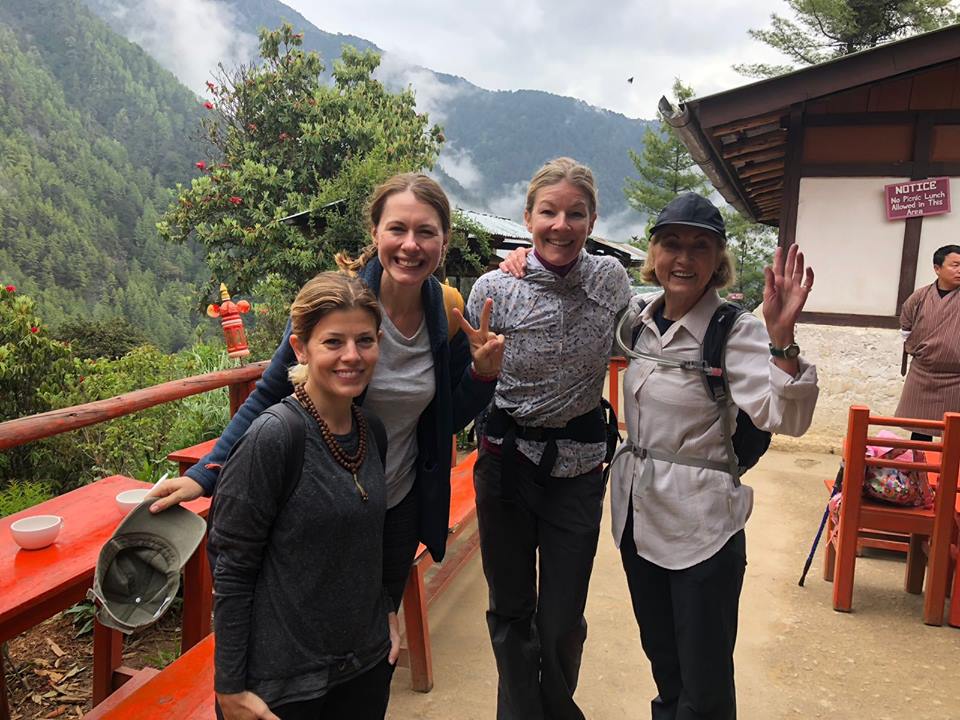 DAY 1: ARRIVAL AT PARO AIRPORT & TRANSFER TO THIMPHU
DAY 1: ARRIVAL AT PARO AIRPORT & TRANSFER TO THIMPHU
We arrive by Druk Air (Royal Bhutan Airline) to Paro (Bhutan) over magnificent views of the world’s highest Himalayan snowcapped peaks. After immigration, Dr. Karma and Johnson will greet you on arrival and take a scenic one hour drive to the capital Thimphu, where we will have lunch and our welcoming circle. Thimphu is sprawled across the wooded western hillside of the Wang Chu and it hosts the Centre of Government, Religion and Commerce. Thimphu is the town where the traditional ways mingle with modern introductions.
After some free time to get settled in, we join together in an Opening Circle of Trust & Yoga. As a group of conscious like-minded travelers, we set a collective intention for our transformational journey together. Then we move into a light de-stressing yoga practice to let go of any tension accumulated from a long day of traveling.
In the afternoon, we will visit the capital fortress, Tashichodzong, which serves as the royal office of His Majesty King and the central monastic body of Bhutan.
After dinner, we will experience an ajna light therapy session to entrain the brain waves into an effortless state of relaxed alertness.
Duration of drive: 1hr Overnight: Thimphu
Elevation 2,320 m | Weather in Thimpu: Hi 22 Lo 13
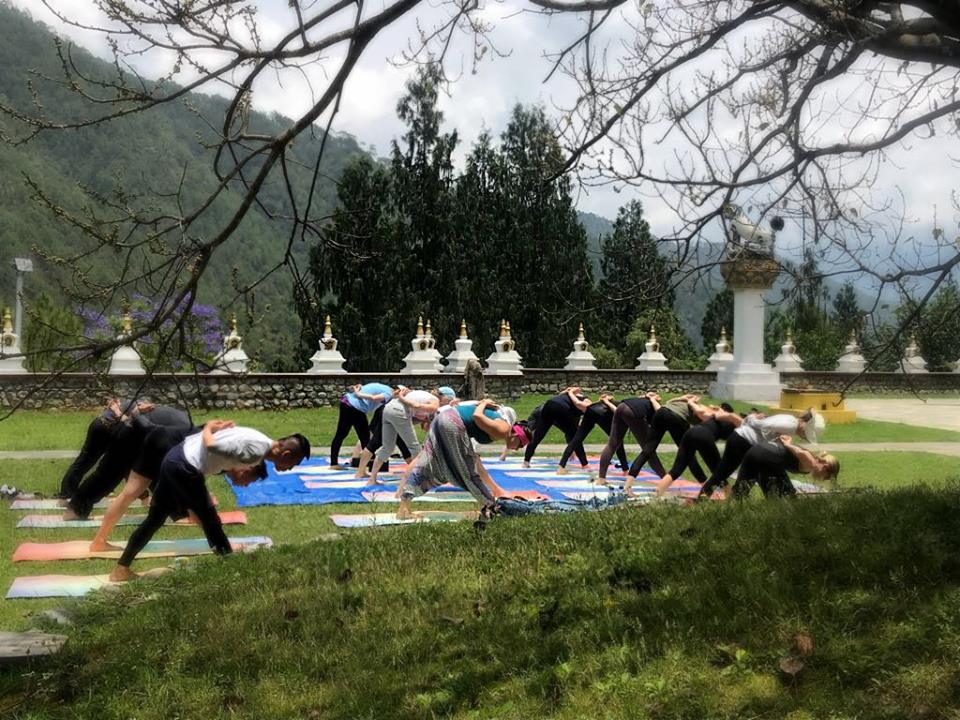 DAY 2: THIMPHU – THE NEW CAPITAL
DAY 2: THIMPHU – THE NEW CAPITAL
7:00 – 8:00 am Yoga
8:00 – 9:00 am Breakfast
7:45 pm – 9:45 pm Inner Guidance Session 1 – This a powerful alchemizing experience that works on accessing inner wisdom & empathy on all levels – Physically, Emotionally, Mentally and Energetically.
Overnight: Thimphu
Elevation 2,320 m | Weather in Thimpu: Hi 22 Lo 13
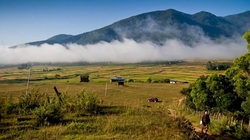 DAY 3: PUNAKHA – THE ANCIENT CAPITAL
DAY 3: PUNAKHA – THE ANCIENT CAPITAL
7:00 – 8:00 am Pranayama and Kundalini
8:00 – 9:00 am Breakfast
After breakfast, we go on a 2 hour stunning drive following the course of the Thimphu Chu (river) onto the high mountain pass of Dochu La (3,050m). On a clear day, we will witness the Himalayan snowcapped peaks towering over us in the backdrop of the 108 stupas erected by the Royal Queens of Bhutan.
Upon reaching Punakha, we will visit the picturesque Punakha Dzong fortress which is the winter residence of chief abbot and central monastic body of Bhutan. It also serves as the administrative headquarters for the Punakha region.
After lunch, hike up to Khamsum Yuelley Namgyal Chorten, which is located on the ridge above the Punakha Valley. This chorten depicts the story of subduing our inner demons. We will practice yoga outside here in the afternoon.
In the evening we will visit a nunnery and meditate in the company of nuns devotionally chanting.
3:00 pm – 4:15 pm Outdoor Yoga
Overnight: Punakha
Elevation 1,300 m | Weather in Punakha: Hi 27 Lo 14
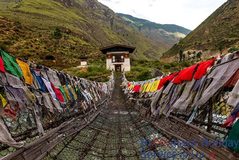 DAY 4: GANGTEY VALLEY EXCURSION
DAY 4: GANGTEY VALLEY EXCURSION
7:00 – 8:00 am Pranayama and Kundalini
8:00 – 9:00 am Breakfast
Today we go on a 2.5 hour journey to Phobjika Valley popularly known as Gangtey Valley at an altitude of 3,000 meters. This glacier valley is home of the rural settlement of the Gangtey Monastery. It is a 453 year old building, and vital to the Pedling tradition of Buddhism in western Bhutan. The valley is one of the most beautiful spots in the country and home to endanger Black Necked Cranes that migrate from northern Tibet to escape its harsh winter. During our time here, we will have the opportunity as a group have a prayer flag ceremony in nature, as well as practice yoga in nature.
7:45 pm – 9:45 pm Inner Guidance Session 2 – This a powerful alchemizing experience that works on accessing inner wisdom & empathy on all levels – Physically, Emotionally, Mentally and Energetically.
Duration of Drive: 2 hours 30 min Overnight: Punakha
Elevation 1,300 m | Weather in Punakha: Hi 27 Lo 14
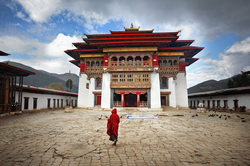 DAY 5: RETURN TO THE PARO VALLEY
DAY 5: RETURN TO THE PARO VALLEY
7:00 – 8:00 am Morning Yoga
8:00 – 9:00 am Breakfast
In the late afternoon, we will visit renovation of ruin Dzong of Drukgyel Dzong followed up by the trip to the oldest Kyichu temple that goes back to 7 centuries.
8:00 pm – 9:00 pm Ajna Light Therapy – Shamanic Symbology through Dream Journeying.
Duration of drive: 3 hrs 30 min Overnight: Paro
Elevation 2,280 m | Weather in Paro: Hi 23 Lo 10
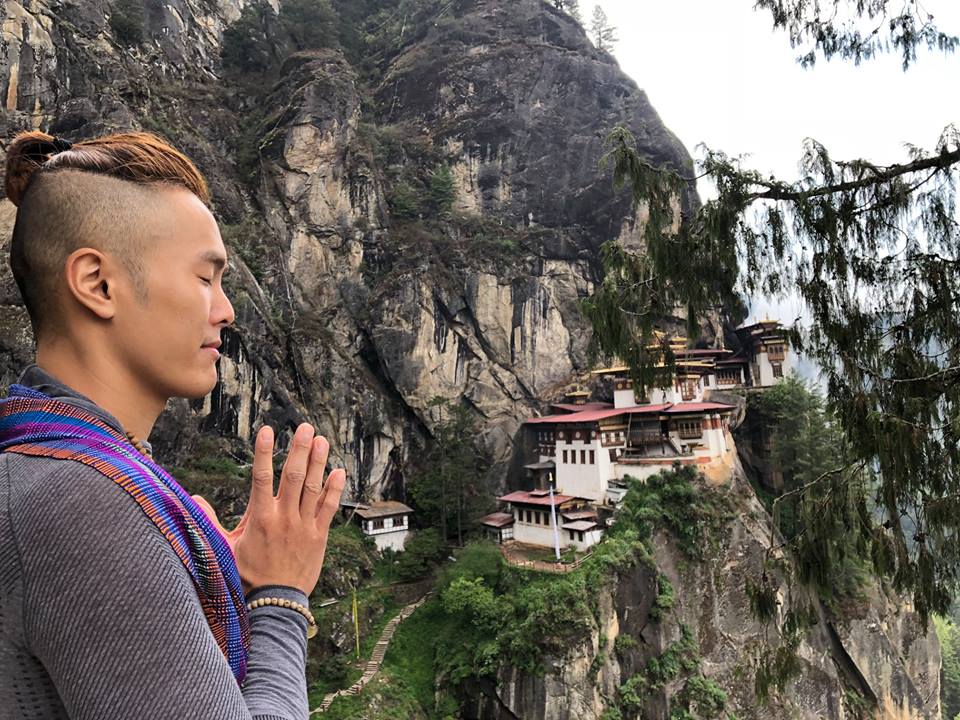 DAY 6: TAKTSANG HIKE – THE TIGER’S NEST
DAY 6: TAKTSANG HIKE – THE TIGER’S NEST
5 am start – Breakfast on the go.
One of the main highlights of the Paro Valley is the Taktsang monastery (Tigers nest), Taktsang is one of the most important pieces of architecture building in Bhutan, Taktsang monastery defies logic, gravity, and reason. As the legend has it, in the 8th century, Guru Rinpoche (Pamasambhava) arrived off the back of flying tigress to subdue the local deities and meditated there for 3 months. Afterwards, the cliffside was considered blessed. It is the most famous of Bhutan’s monasteries, miraculously perched on the side of a sheer cliff 900 m above the floor of the Paro Valley. It will be a challenging climb, but well worth the arduous journey. We will have an early start, to avoid the hot sun for a 2.5 hour climb. On the way, we visit Kyichu Lhakang, one of 108 monasteries, and oldest temple from the 7th century built over a subdued demon’s body by Tibetan King Songtsen Gempo.
In the late afternoon before dinner, we will spend much needed time to recover and rest with Restorative Yoga. After dinner, we will create an Energy Sound Circle for a deep inward experience of our vibrational nature.
Duration of hike: 5 hrs up and down | Difficulty: moderate to hard | Overnight: Paro
Elevation 2,280 m | Weather in Paro: Hi 23 Lo 10
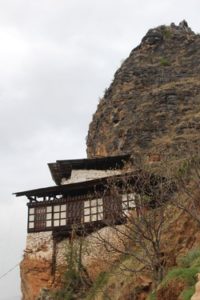 DAY 7: DRAKARPO – THE ABODE OF THE GODS or INTERNATIONAL DEPARTURE
DAY 7: DRAKARPO – THE ABODE OF THE GODS or INTERNATIONAL DEPARTURE
6:00 – 7:00 am Yoga
7:00 – 8:00 am Breakfast
Dra Karpo Temple in the morning is around 20 minutes drive from our resort and it is a 30 minutes uphill walk to the temple
It is known as the ‘Abode of Gods’ in Shaba (Paro Dzongkang) and is considered one of the holiest and most sacred monasteries in Bhutan.
If you carefully observe the Monastery, it is located on the heart of the cliff. Legend has it that Guru Rinpoche cleared out some rocks from the cliff to create space for his meditation. The removed rocks were stacked on an adjacent cliff nearby which you can still see to this day. The monastery dates back to 17th century and is built on a mountain dotted with underground caves. One of the caves has a small ladder for not-so fainthearted to climb down. It leads you into a large cavern that soon turns into very narrow crevasse.
After lunch, we will have an audience with a renowned Rimpoche/Trulku (spiritual teacher) about metaphysics.
6:00 pm –7:15 pm Yoga & Meditation
Difficulty: easy to moderate | Overnight: Paro
Elevation 2,280 m | Weather in Paro: Hi 23 Lo 10
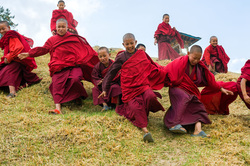 DAY 8: FLY TO BUMTHANG
DAY 8: FLY TO BUMTHANG
7:00 – 8:00 am Yoga
9:00 – 10:00 am Breakfast
After lunch, we head to the domestic airport, to take a 30 min flight to the remote valley of Bumthang, 11:00 – 11:35 am which would otherwise be a 10 hour drive.
Bumthang is the most historical valley visited by the great Buddhist saint from India, Guru Rinpoche in the 8th century A.D. Bumthang also served as the home of famous saints of Nyingma School, such as Longchen Rabjampa (1308-1521) of Tibet who was exiled to Bhutan for more than 10 years and Terton Pema Lingpa, the reincarnation of Longchen Rabjampa, to whose descendants the present dynasty traces its ancestry.
In the afternoon a visit to Jakar Dzong, the ‘dzong of the white bird’. A picturesque location overlooking the spectacular Chhoekhor valley.
We will spend the evening before dinner resting, writing, and integrating.
7:45 pm – 9:45 pm Inner Guidance Session 3 – This a powerful alchemizing experience that works on accessing inner wisdom & empathy on all levels – Physically, Emotionally, Mentally and Energetically.
Duration of drive: 2 hours Overnight: Lechuna Heritage Lodge
Elevation 2,670 m | Weather in Paro: Hi 21 Lo 8
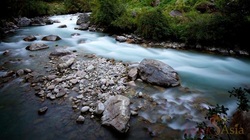 DAY 9: BUMTHANG SIGHTSEEING and TRONGSA
DAY 9: BUMTHANG SIGHTSEEING and TRONGSA
7:00 – 8:00 am Yoga
8:00 – 9:00 am Breakfast
Today’s program begins by driving to Yotong (2955m), a group of village homes clustered together in the valley by the Haa Chhu River. An old trail leads 150m uphill to the Gompa , dedicated to the Guru Rimpoche and his 8 manifestations. Standing among a few farmhouses, this 300-year structure was built by the 16th Je Khempo (Head Abbot of Bhutan).
5:00 pm – 6:15 pm Yoga & Meditation
Drive to Overnight: Lechuna Heritage Lodge
Elevation 2,670 m | Weather in Paro: Hi 21 Lo 8
DAY 10: DEPARTURE
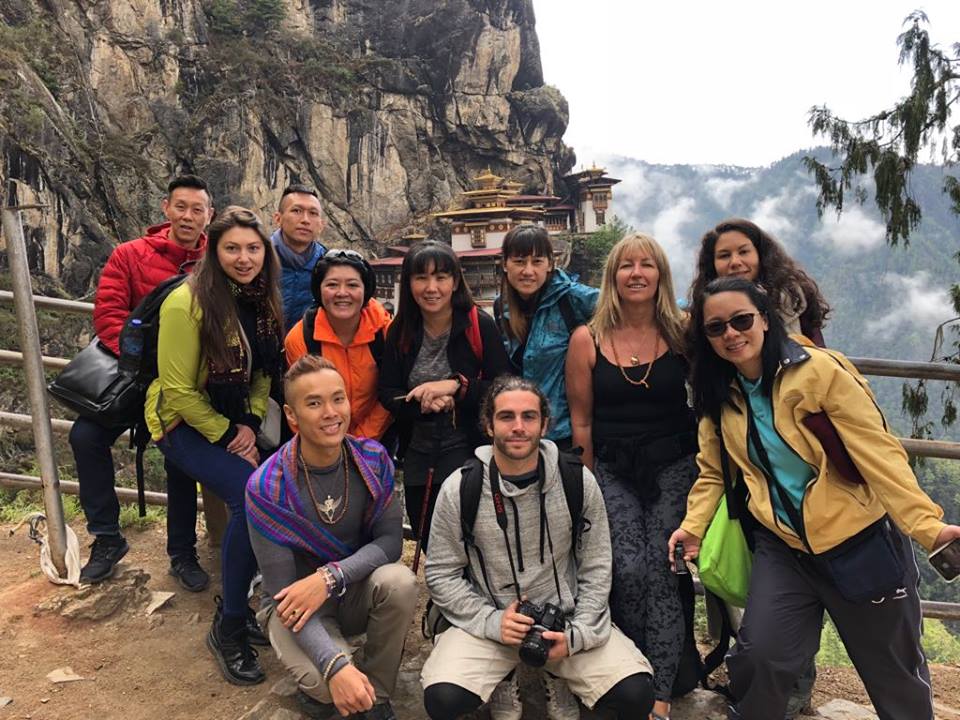
7:00 – 8:30 am Yoga & Meditation
8:30 – 9:30 am Breakfast
You have the opportunity to wander the streets and peruse the markets and purchase wares for souvenirs, or find yourself in a spa to prepare yourself for your flight home. If you are leaving for Bangkok, you will be transferred around 14:00 to the airport. And that will be your farewell of your Bhutanese pilgrimage, until the next one.
Flight Paro – Singapore 16:00 – 21:35
FAQs About Bhutan
 Why Visit Bhutan?
Why Visit Bhutan?
Bhutan is no ordinary place. It is an amply modern country yet medieval with one foot still rooted in its past. Bhutan is aware of the downsides of rapid modernization and has decided to move cautiously without losing its soul. Sustainable socio-economic development, preservation and promotion of culture and tradition, and preservation and protection of natural environment are at the forefront of government policy. Every decision is carefully weighed for the benefit of its people. The government’s ‘high value-low volume’ tourism policy is therefore a good example of its efforts to keep foreign influences at bay while nurturing Bhutanese values at home. This gives Bhutan a different look and feel altogether, a visual and spiritual feast for all visitors.
 High Value, Low Tourism
High Value, Low Tourism
A high volume of tourism may seem like a good thing for Bhutan’s economy, but for the Bhutanese, protecting their culture and environment is most important. Bhutan’s Royal Government used to limit the number of tourists entering the country. Officials believed that unrestricted access to the country would have a negative impact on the natural environment and ancient cultural traditions. This belief led to the notion of “High Value, Low Volume” tourism. Tourism, like all Bhutanese industries must be sustainable and environmentally friendly.
The government wanted tourists to understand the feel the deep-rooted culture and traditions, so they would have a higher appreciation for their surroundings.
Tourism has become the second highest economical contributions to the Bhutan economy, after the agricultural industry. Recently, the government decided to increase the tourism rate. The Tourism Council of Bhutan extended the tourism areas to include once protected communities, natural reserves, and ancient cultures.
 Gross Happiness Index
Gross Happiness Index
Bhutan is known famously as the first country in the world to measure progress based on happiness. To do so, the 4th Druk Gyalpo coined the term Gross National Happiness (GNH). From then on, GNH was used to measure the country’s development instead of Gross National Product (GNP).
The happiness of the Bhutanese is more important than material growth and there should be a balance between to two. A GNH Commission was created to take an annual measure of how the people fare. The poll is based on an index of nine domains. Living standards, education, health, cultural diversity and resilience, community vitality, time use, psychological wellbeing, ecological diversity, and good governess are the nine domains that are taken into account. According to the GNH Commission, 81.5% of the population of Bhutan is deeply happy. The Commission is still working on ways to achieve total happiness for 100% of Bhutanese.
Brief History of Bhutan
 Founded in early 2000 B.C., Bhutan was known by many names. Some of the names included Lho Jong, Lho Mon Kha Shi, Lho Jong Men Jong, and more. During the 17th century, it became officially known as Druk Yul, the “Land of the Drukpas”. Drukpas referred to the religion of Buddhism that the people began to practice, which is now the dominant religion of the country. Previously in the 7th century, Bonism was the religion in Bhutan until the Tibetan King Songtsen Gampo and Guru Rinpoche introduced and taught the people the details of Buddhism.
Founded in early 2000 B.C., Bhutan was known by many names. Some of the names included Lho Jong, Lho Mon Kha Shi, Lho Jong Men Jong, and more. During the 17th century, it became officially known as Druk Yul, the “Land of the Drukpas”. Drukpas referred to the religion of Buddhism that the people began to practice, which is now the dominant religion of the country. Previously in the 7th century, Bonism was the religion in Bhutan until the Tibetan King Songtsen Gampo and Guru Rinpoche introduced and taught the people the details of Buddhism.
Ngawang Namyel, the first Zhabdrung, established his power after he arrived in 1616 A.D. He defeated several Tibetan armies and unified battling Bhutan tribes. He started a governing system that was followed until his death. The system broke down and infighting began. A new system of government began with the establishment of a monarchy. The first Druk Gyalpo, or Dragon King provided rules for Bhutan citizen to have a better way of life. In 1971, Bhutan officially became a participating member of the United Nations.
Food and Cuisine
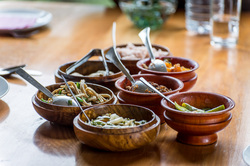 Bhutanese cuisine is influenced by Chinese, Tibetan and Indian culture. The main dish, which generally includes white or red rice, seasonal vegetables, and meat (pork and chicken), are often cooked with chili or cheese. If you like Chinese food, you should be rather comfortable with Bhutanese food. However, do note that the Bhutanese like to cook their food with cheese so you would often see a portion of the selection containing cheese.
Bhutanese cuisine is influenced by Chinese, Tibetan and Indian culture. The main dish, which generally includes white or red rice, seasonal vegetables, and meat (pork and chicken), are often cooked with chili or cheese. If you like Chinese food, you should be rather comfortable with Bhutanese food. However, do note that the Bhutanese like to cook their food with cheese so you would often see a portion of the selection containing cheese.
However, don’t be too worried if you aren’t able to take it too spicy. A majority of Bhutan’s professional chefs take into account the foreigners’ less spicy taste. Most restaurants in Bhutan offer customers a range from Continental to Chinese, and from Bhutanese to Tibetan and Indian cuisine. International fare is usually limited, but most hotels offer dinner in buffet style, which includes many different cuisines. Whenever you are dining out, always inquire what is available and what is in season. In a restaurant the full cutlery ensemble will usually be provided, but in a local café you may be limited to the option of a spoon or using your right hand and bowl of rice to mop up the meal.
_______________________________________________________________________
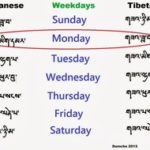 Language
Language
The official language in Bhutan is Dzongkha. Bhutanese also speak Tshanglakha and the Lhotshamkha. Tshanglakha is spoken in the western region of the country and Lhotshamkha is used by the southern Bhutanese. There are at least 19 dialects of Dzongkha that are spoken all over Bhutan. Most of the people that are in the tourism industry speak English. It is also being taught in schools.
_______________________________________________________________________
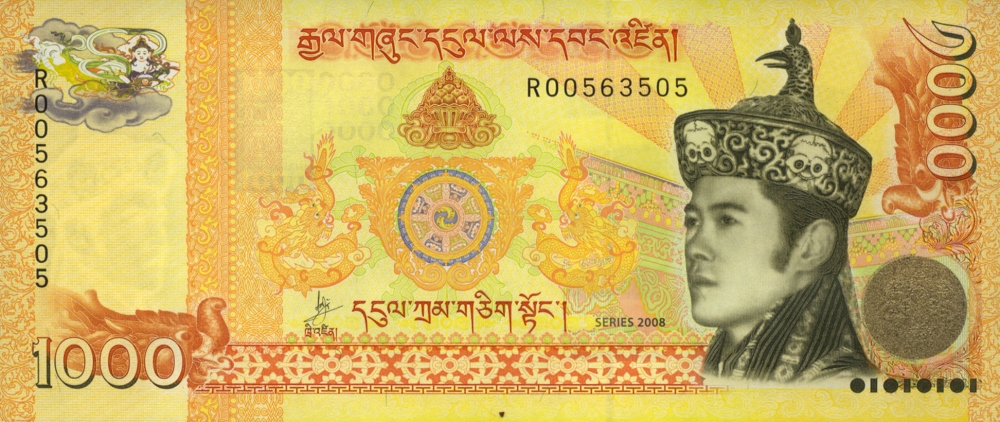 Currency
Currency
The Ngultrum (NU) is Bhutan’s currency. Until the 1960’s, Bhutanese bartered goods and services because there was no paper money. Today, in addition to ngultrum, you can use Indian rupees at different shops and restaurants around the country.
________________________________________________________________________
 Climate
Climate
The climate changes with the elevation. Because there are mountainous regions as well as plains and valleys, the temperature can range from subtropical to arctic. Spring, summer, monsoon, autumn, and winter are the five seasons in Bhutan. It snows most of the year in the northern area. The southern region of Bhutan has a year-round subtropical atmosphere. The central region is cool with dry winters. Eastern Bhutan is dry and warm while the west has heavy Indian monsoon rains that last between June and September.
________________________________________________________________________
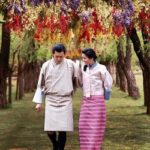 Bhutan’s King and Queen
Bhutan’s King and Queen
His Majesty, the King Jigme Khesar Namgyel Wangchuck was extremely popular even before he married a commoner, Jetsun Pema. His family line has welcomed the throne for the past 100 years. He is the fifth ruler in his family to take possession on the crown. Bhutanese admire and love the royal family.
_________________________________________________________________________
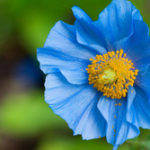 National Flower
National Flower
The national flower of Bhutan is the Himalayan Blue Poppy or Euitgel Metog Hoem. This unique flower grows above tree level on rocky mountain regions.
_________________________________________________________________________
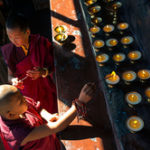 State Religion
State Religion
The official religion is Vajrayana Buddhism. Bhutan is the last kingdom to practice Vajrayana Buddhism. The teachings allow one to embody both mind and body. You will reach enlightenment if you follow and understand the concepts of emptiness, wisdom, compassion, and skillful means.
________________________________________________________________________
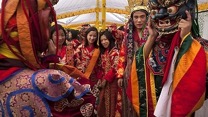 Culture and Costume
Culture and Costume
For generations the Kingdom of Bhutan has isolated its culture and society from outside influences. This drive is to insure the protection of ancient teachings. Today, these teachings are passed on through festivals and other events that tell stories of their ancestry. Bhutanese dress in festive costumes, some with masks and created detailed recreations and dances that entertain and bestow onto others the Bhutanese spiritual life story.
________________________________________________________________________
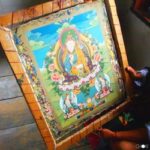 Buddhist Paintings
Buddhist Paintings
Buddhist paintings are found in dzongs, goembas, and lhakhangs. The hand-painted murals tell stories that deliver messages of peace and harmony. One example is the Thuenpa Puen Shi (Four Friends) mural depicts the harmonious efforts between a monkey, peacock, elephant, and a rabbit. The four decided to work together to grow fruit that they all wanted to eat. Each had a job and through cooperation and harmony, they were able to reach the fruit after it had grown into a tree.
________________________________________________________________________
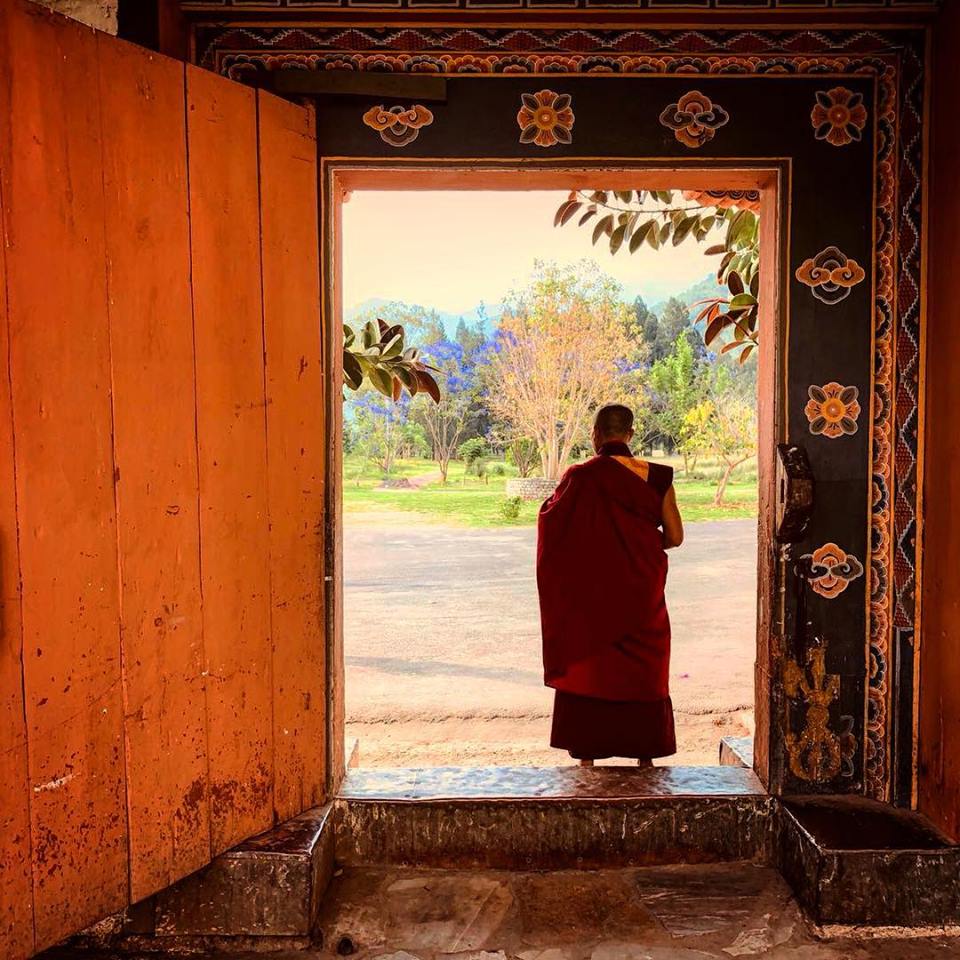
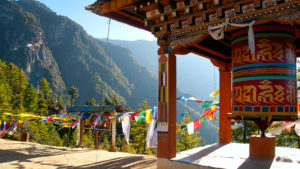 Prayer Wheel
Prayer Wheel
A prayer wheel is a cylindrical wheel with a hand carved mantra on the outside, Om Mani Padme Hum, and printed prayers on the inside. They are usually made of wood, stone, brass, tin, or coarse cotton. Spinning the wheel clockwise will release the prayers into the world and purify negative energies. It also releases blessings and wishes. Prayer wheels can be spun by hand, water, or fire. Water powered prayer wheels blesses the water as it touches the wheel. Those prayers flow to rivers, lakes, and oceans. Heat emanating from a lit candle or electric light spins fire prayer wheels. The light passes its blessings to everyone it touches.
________________________________________________________________________
National Animal
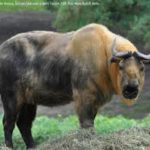 The Takin, or gnu goat is Bhutan’s national animal. It lives in forested areas in mountain areas of 4,000-meter altitudes and above. Takin’s have a stocky body on short legs with two-toed hoofed feet. It has a long nose and stout horns. These animals feed on bamboo, grass, leaves, and other plants. Takin are rare, therefore they are an endangered species.
The Takin, or gnu goat is Bhutan’s national animal. It lives in forested areas in mountain areas of 4,000-meter altitudes and above. Takin’s have a stocky body on short legs with two-toed hoofed feet. It has a long nose and stout horns. These animals feed on bamboo, grass, leaves, and other plants. Takin are rare, therefore they are an endangered species.
_________________________________________________________________________
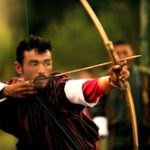 National Sports
National Sports
Archery became Bhutan’s national sport in 1971. Although only men were allowed to play during festivals, tournaments, and religious celebrations, Tshering Choden was the first female archer to be asked to enter the Summer Olympic Games.
Retreat Pricing
Investment for this unique transformational experience into the Kingdom of Happiness
7 DAYS, 6 NIGHTS (May 13 – 19, 2021)
May 13 – Singapore, Bangkok, Kathmandu or India to Paro
May 19 – Paro to Singapore, Bangkok, Kathmandu or India to Paro
Twin Deluxe Shared $3800 USD per person
Single room $4600 USD per person
10 DAYS, 9 NIGHTS (May 13 – 22, 2021)
May 13 – Singapore, Bangkok, Kathmandu or India to Paro
May 22 – Paro to Singapore, Bangkok, Kathmandu or India to Paro
Twin Deluxe Shared $4,600 USD per person
Single room $5,400 USD per person
EARLY BIRD DISCOUNT of $200 if deposit is paid and registered by Dec 31, 2020
_________________________________________________________________________________
PAYMENT OPTIONS
International bank transfer details can be found below, or you may pay via credit card/paypal which incurs an additional 4.5% fee
Bank Transfers: Non-refundable deposit of $1000 USD is required to confirm your booking and to confirm your spot on the flight. *COVID – 19 refunds are possible. We will have a clearer understanding of travel restrictions towards the end of 2020.
Paypal/Credit Card: Entire payment needs to be processed at once.
 CHARITY
CHARITY
A percentage of the package goes to Draktsho which is a non-profit organization working to help Bhutanese children and youth living in various types of disabilities. They work to try and empower the children through education and vocational training, while trying to eventually integrate them back into the mainstream population.
Draktsho’s aim is to equip the trainees with skills to enhance their opportunities for gainful employment. They also try and build self-esteem and self-reliance, thereby making the trainees independent, confident and contributing members of the Bhutanese society. One of the greatest challenges for Draktsho is to erase the deeply embedded stigma where people think that the disabled cannot learn and earn a living.
Draktsho also helps train Bhutanese special Olympic athletes. These athletes have gone on to represent Bhutan in numerous national level sporting events, some becoming the most decorated athletes in Bhutan. Draktsho gets no funding for training and sending these special athletes to these events.
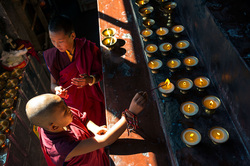 Package Includes:
Package Includes:
*International roundtrip airfare on Royal Druk Airlines from SG, BKK or Calcutta to Paro.
*The 3-4 star Accommodations in Twin and Deluxe Rooms.
*All Meals (Breakfast, Lunch, Dinner)
* Unlimited Mineral Water
* Tea and Snacks
* All Transport within Bhutan (Coaster Bus and 1 Luggage Van)
*Services of expert Bhutanese guides
*Cultural Programs
*River Rafting
*Special entry fees
*High Peak Travel Visa of $250 per day and surcharges
*35% Government surcharge that goes towards free healthcare, education and social development
Package Prices excludes:
 Travel and Cancellation Insurance (all attendees MUST purchase insurance prior to arrival)
Travel and Cancellation Insurance (all attendees MUST purchase insurance prior to arrival)
*Laundry, Telephone, mobile, fax and internet bills
*Tips for guide and driver ($100-$150 suggested)
* Alcohol, Beverages in Resorts
* Shopping and personal expenses
Please email info@exodusretreats.com to reserve your space on this retreat. Upon doing so, you will receive an email confirming availability for your selected dates and confirming a hold period for three days. To confirm your reservation, a NON-refundable deposit of $1000 USD is required to be paid immediately to secure your booking. Payment can be made via bank transfer or paypal.
The FULL balance of the payment is due 60 days prior to the retreat start date (March 13, 2021) . If your booking falls within 60 days, full payment will be due immediately. Payment details will be provided to you upon reservation (via bank transfer or Paypal.) Please note that Paypal and credit card payments incur a 4.5% charge.
Bank Transfer Details
Bank Name: DBS
Name: Sagehouse Pte Ltd
Account number 033-905101-2
7171 033
Swift Code: DBSSSGSG
252 North Bridge Road, #02-26A/B Raffles City Shopping Centre, 179103
*Make sure you send it as an international transfer if you are based in Singapore, as this account accepts multiple currencies.
Travel Details
![]()
![]() Flight Recommendations:
Flight Recommendations:
Note that the only airline flying in and out of Bhutan is Drukair. Flights from Bangkok, Thailand and Kathmandu, Nepal have daily arrivals. Other flights use Singapore, Dhaka, Bangladesh, Sydney, Australia, and Kolkata, Bagdogra, and Gaya, India.
For those coming from a different city other than Singapore, we will be able to help you arrange the flight from the other ports of entry into Bhutan.
We highly suggest organizing your flight to Singapore or Bangkok, as they are by far the most convenient transit points of entry into Bhutan.





What to Look Forward to
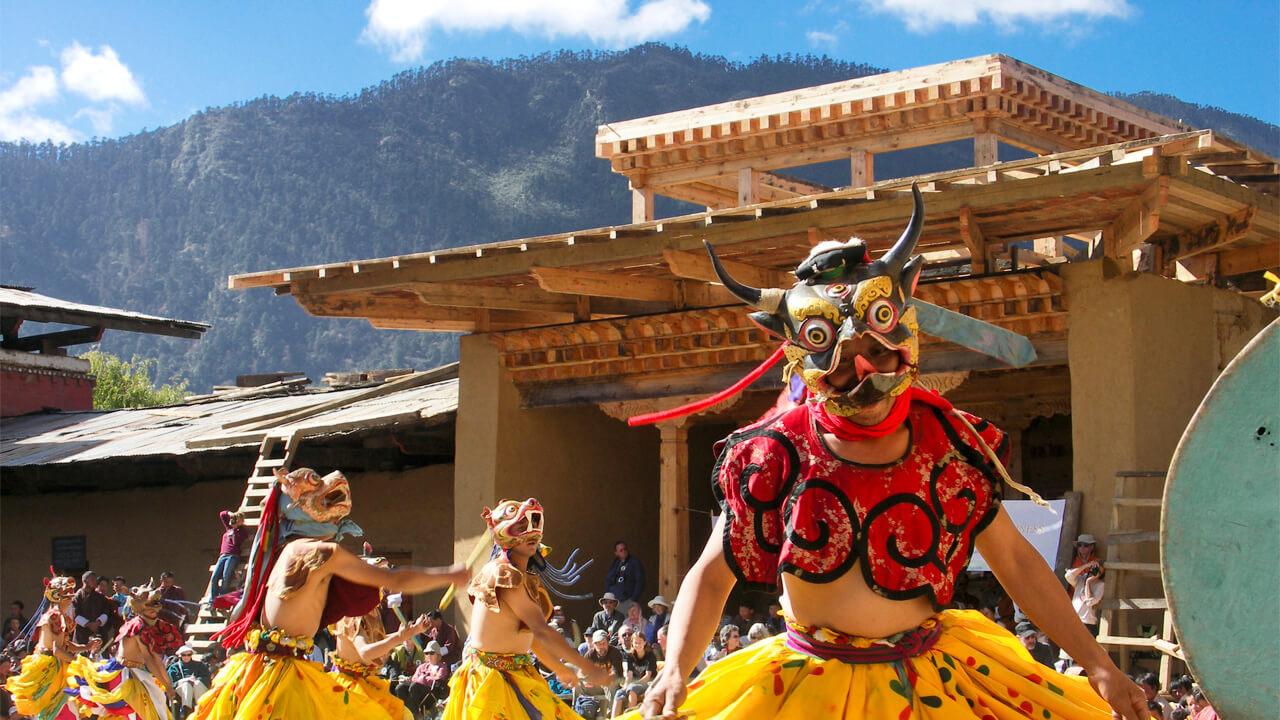
![]()
![]() Expert guides who are not run of the mill tour guides, but who live a holistic life aligned to the evolution of the Self while improving the lives of all those they encounter.
Expert guides who are not run of the mill tour guides, but who live a holistic life aligned to the evolution of the Self while improving the lives of all those they encounter.
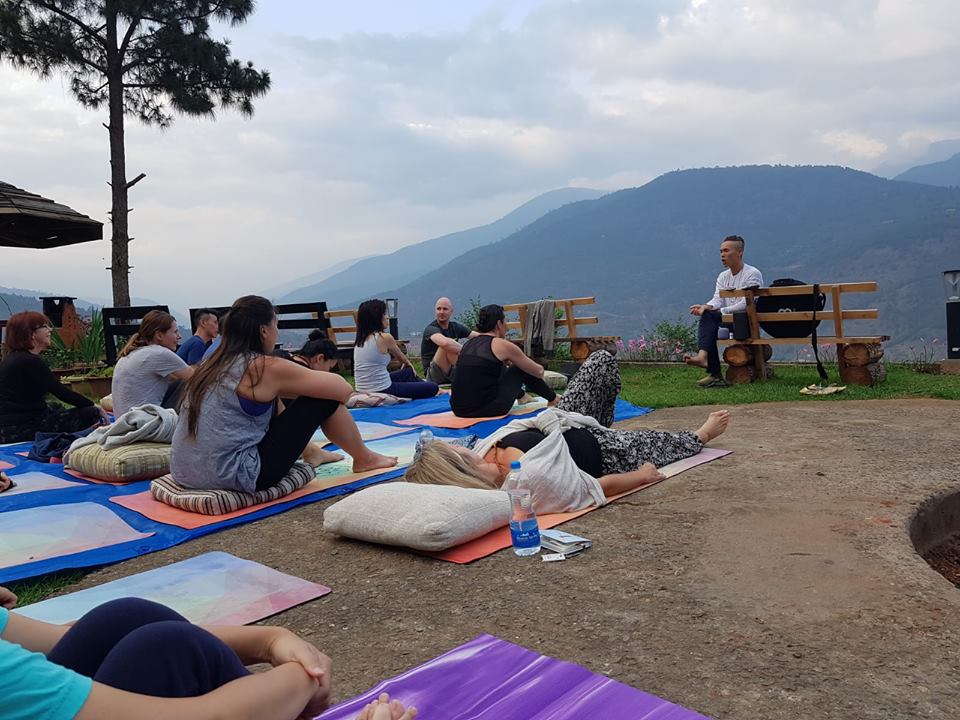 Transformational experiences through yoga, meditation, breath work, ajna light therapy, inner visualization, inner guidance, energetic rituals, special blessings, and more.
Transformational experiences through yoga, meditation, breath work, ajna light therapy, inner visualization, inner guidance, energetic rituals, special blessings, and more.
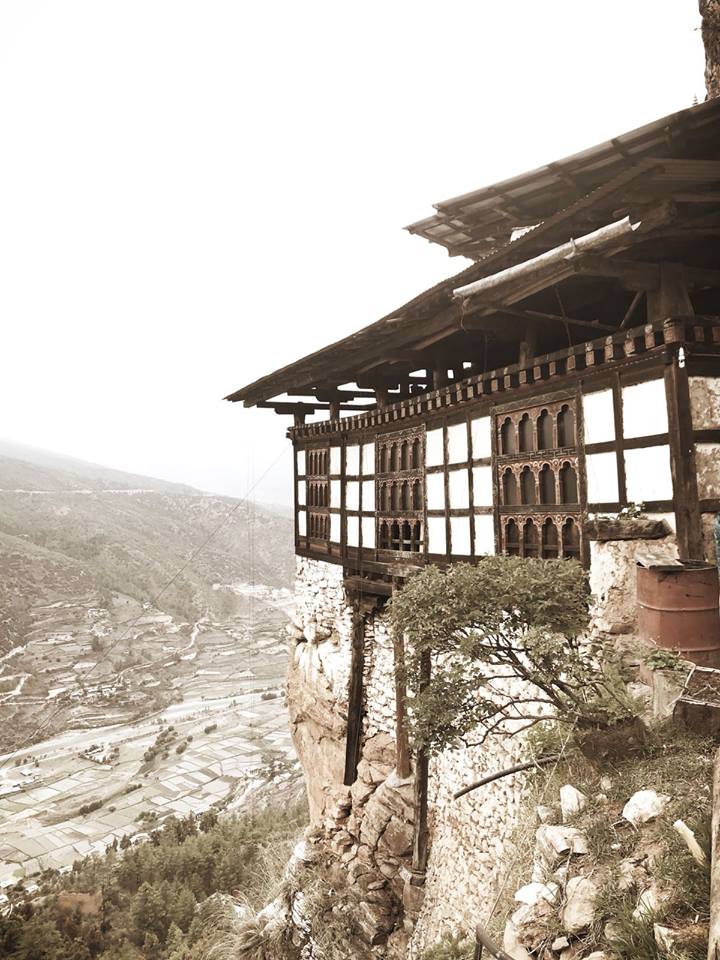 Extraordinary visits to cultural landmarks, sacred sites, monasteries and a special pilgrimage to the Tiger’s Nest Monastery.
Extraordinary visits to cultural landmarks, sacred sites, monasteries and a special pilgrimage to the Tiger’s Nest Monastery.
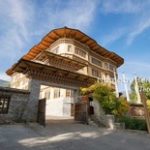 The Bhutanese culture is very hospitable and treat visitors like extended family. Expect to feel at home at our carefully selected 4 star boutique hotels.
The Bhutanese culture is very hospitable and treat visitors like extended family. Expect to feel at home at our carefully selected 4 star boutique hotels.
 After the journey is over, you have unforgettable memories, new friends and unimaginable life changes that will affect you for years to come.
After the journey is over, you have unforgettable memories, new friends and unimaginable life changes that will affect you for years to come.
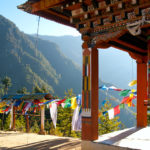 You will be more immersed in yourself and not the worries of work, relationships and the expectations that come with urban living. You will connect more deeply with your true passions.
You will be more immersed in yourself and not the worries of work, relationships and the expectations that come with urban living. You will connect more deeply with your true passions.
What People Are Saying
Barbara Schmidt – Creative Director & Entrepeneur
New York, USA
Merle Cockerill – Asset Management
Sydney, Australia
Agnes Wong – Business Management
Kuala Lumpur, Malaysia
Rosslyn Valentine – Retired
Sydney, Australia
Will Lee – Marketing Professional
Singapore
Teri Perry – Retired
Massachusetts, USA
Sharon Tan & Doreen Leow
Singapore
Andrea Wieser – Asset Management
Switzerland
Dan Tam – Creative Designer
Singapore
Cushla Beasley – Director of Building & Construction
New Zealand
Soo Leng Tay – Business Management
Singapore





What You Need to Know
THIS RETREAT IS LIMITED TO 10 PEOPLE TO MAINTAIN AN INTIMATE EXPERIENCE. TO ENSURE WE DELIVER THE BEST EXPERIENCE TO YOU, PLEASE EMAIL INFO@EXODUSRETREATS.COM WITH ANSWERS OF THE QUESTIONNAIRE BELOW:
Please answer the following questions in your email:
1) Do you have a regular yoga or meditation practice? If so for how long?
2) What is your view on spirituality and how open are you to new and unfamiliar experiences?
3) Do you have any food allergies or medical conditions that need to be taken into consideration?
4) What are the 3 main things in which you are actively seeking to transform your life at this point in time? Please be specific.
Please answer with honesty and a willingness for a committed journey deep into the heart of the Self. Emails will be followed up with a phone call or Skype meeting.
